Conditions
-
- Design Semisubmersible For Use In Arctic Ice Conditions Maritime Reporter, Oct 1981 #48
icestrengthened semisubmersible mobile offshore drilling unit has been developed by MACS of Aberdeen, Scotland. The unit has received warm interest, according to John McLean, head of MACS's design department.
Mr. McLean reported recently that four major oil companies and two drilling contractors had expressed interest for possible use on the Canadian east coast and other Arctic locations where offshore drilling is limited to the ice-free season.
The design, dubbed the "Ice Maiden," calls for a 40,300-ton unit capable of drilling in 1,600 feet of water on anchors and up to 6,000 with the use of dynamic positioning.
A model of the rig is currently undergoing ice tests in Wartsila's laboratory, Finland, and has received initial design approval from Det norske Veritas.
"The vessel will extend the drilling season and will be the first to be able to go into and out of ice under its own power and in safety," said Mr. McLean.
-
- Gems Paddle Switches Monitor Flow Conditions —Literature Available Maritime Reporter, Jul 1981 #9
Paddle flow switches are available from Gems Sensors Division of Transamerica Delaval to provide a flow or no-flow condition for shipboard and other marine applications. The FS-550 paddle units are said to offer the same quality and reliability that has been provided by other Gems flow controls
-
- Ocean Engineering Under Arctic Conditions Is Subject Of Conference Maritime Reporter, Aug 1977 #34
The Canadian province of St. John's, Newfoundland, will be the site of the 4th International Conference on Port and Ocean Engineering Under Arctic Conditions, to be held September 26-30. The POAC 77 Conference will cover latest developments on operating in Arctic waters, including oceanography, hydrocarbon
-
- Experimental LNG Carrier Will Evaluate Two Tank Systems Under Operating Conditions Maritime Reporter, Feb 1974 #24
of liquids in the tanks. 4. After cooling the tanks with liquid nitrogen until the working temperature is reached, the insulation, cooling conditions and the deformation of the tanks and the hull will be checked. 5. After the ship has sailed as an ethylene carrier, long-term tests will be
-
- STAUFF Hydraulic Tester Simulates Operating Conditions Marine News, Nov 2013 #56
The SDMKR reversible flow device by STAUFF rapidly and accurately monitors hydraulic components. The design allows simultaneous measurement of flow, pressure, and temperature, allowing personnel to determine the performance of pumps, motors, valves, or cylinders, as well as complete systems. The portable
-
- New Oil Spill Tech Solutions Put to the Test Maritime Reporter, Jul 2018 #25
Research & Renewable Energy Test Facility conducts testing, training and research with full scale equipment using real oil in repeatable simulated sea conditions.Managed by the Bureau of Safety and Environmental Enforcement (BSEE), Ohmsett is committed to helping improve the methods and technologies available
-
- World’s Largest Containership First Tested at MARIN Maritime Reporter, Nov 2014 #30
scope of work, combining numerical predictions and basin model tests to provide the most complete qualification of the vessel’s behavior in various sea conditions. An important yet unfortunately, too rare, feature of this project was that MARIN could count not only on the support of the shipyard but also on
-
- OTT Hydrometry & the New Monitoring Network for Scottish Ports Marine Technology, Sep 2015 #50
Historically, ferry masters operating off the west coast of Scotland would have to sail to a port and on arrival visually assess the weather and tide conditions before deciding whether safe berthing alongside the pier or quayside would be possible. This wastes time and fuel, and can causes immense frustration
-
- Maritime Digitalizaton: The Electronic Lookout Maritime Reporter, Apr 2021 #50
. Dynamic Positioning, for example, has become a mainstream vessel control technology whose advancing capability not only responds to but anticipates conditions, based on accumulated data.Predictive algorithms are now also being used to enhance safety in other areas of ship control, including maneuvering
-
- Strategic Planning With Aggregate Data Maritime Reporter, Apr 2014 #30
combined and aggregated at a higher level. At a higher level the whole vessel can be seen as a moving sensor that is collecting data from environmental conditions as well as the performance of the vessel. Similarly as the information received from a single sensor is limited, it is inadequate to interpret the
-
- Riders on the Storm Marine News, Oct 2015 #38
need to operate faster than ever before. The people on them would need to be ‘fit to fight’ determined adversaries after a fast transit in extreme sea conditions. As high speed craft designers and professional sector boat builders rose to the challenge they built in ‘over engineering’ wherever possible. In
-
- US Inland Waterways: Looking for Rainmakers Marine News, Nov 2022 #34
issued a force majeure notice (force majeure - unforeseeable circumstances that prevent someone from fulfilling a contract).“Chronic low water conditions throughout the inland river system have had a negative effect on many who rely on the river, including Ingram Barge. We informed customers yesterday
-
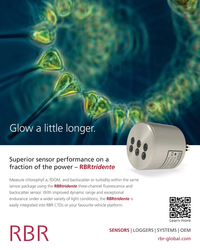 )
March 2024 - Marine Technology Reporter page: 4th Cover
)
March 2024 - Marine Technology Reporter page: 4th Coverfuorescence and tethree-channel fuorescence and ynamic range and exceptional backscatter sensor. With improved dynamic range and exceptional ght conditions, the RBRtridente is endurance under a wider variety of light conditions, the RBRtridente is easily integrated into RBR CTDs or your favourite vehicle
-
 )
March 2024 - Marine Technology Reporter page: 40
)
March 2024 - Marine Technology Reporter page: 40Nm and a unique naval architecture that enables the USV hicles (ROTVs), inspection-class Remotely Operated Vehicles to withstand the most severe ocean conditions, the new DriX (ROVs), as well as Autonomous Underwater Vehicles (AUVs). O-16 has been designed for long-duration operations (up to Its gondola
-
 )
March 2024 - Marine Technology Reporter page: 39
)
March 2024 - Marine Technology Reporter page: 39for quality as- surance or end-users to characterize batteries before selecting one for critical use. Testing must replicate the expected ? eld conditions, espe- cially temperature and current drain. Use your own data to drive your decision. FURTHER READING Landereans are encouraged to follow their
-
 )
March 2024 - Marine Technology Reporter page: 38
)
March 2024 - Marine Technology Reporter page: 38, known as Eneloop, is may be saved and printed. Multiple test graphs of the same bat- currently only available as AA and AAA. tery under different conditions, or multiple batteries under simi- lar conditions, may be overlaid and compared. (See Figure 7.) Test result labels can be printed to put on
-
 )
March 2024 - Marine Technology Reporter page: 35
)
March 2024 - Marine Technology Reporter page: 35Figure 1 A self-righting vehicle design with buoyancy high and weight low, WHOI’s SeaBED AUV captures the attention of a pair of curious Antarctic penguins as it is deployed from the British research vessel James Clark Ross. Vehicle designers allowed for temperature reduction of battery capacity. Recharge
-
 )
March 2024 - Marine Technology Reporter page: 25
)
March 2024 - Marine Technology Reporter page: 25System Requires only UK, Maxlimer mapped the shape of the Wavelet 2KW at 250ms Ping Rate CorrelaO on > 0.96 caldera and measured the environmental conditions of water above it. Sensors on board collected additional data, explained SEA-KIT Operations Director Ash Skett, including bathymetric and water
-
 )
March 2024 - Marine Technology Reporter page: 19
)
March 2024 - Marine Technology Reporter page: 19About the Author vey with the pipe tracker is not required, resulting in signi? - Svenn Magen Wigen is a Cathodic Protection and corrosion control cant cost savings, mainly related to vessel charter. expert having worked across The major advantage of using FiGS on any type of subsea engineering, design
-
 )
March 2024 - Marine Technology Reporter page: 17
)
March 2024 - Marine Technology Reporter page: 17of method depends on factors like the struc- curate calculations of anode currents to assess remaining life, ture’s location, depth, environmental conditions, and the spe- nor determine issues with current drain to or from adjacent ci? c requirements of the maintenance plan. structures. The most common
-
 )
March 2024 - Marine Technology Reporter page: 16
)
March 2024 - Marine Technology Reporter page: 16TECH FEATURE IMR Image courtesy FORCE Technology OPTIMIZING CATHODIC PROTECTION SURVEY USING NON-CONTACT SENSORS By Svenn Magen Wigen, FORCE Technology he principle behind sacri? cial anodes, which are water structures, reducing the need for frequent repairs and used to safeguard underwater pipelines
-
 )
March 2024 - Marine Technology Reporter page: 13
)
March 2024 - Marine Technology Reporter page: 13to one of the most the need to operate in more diverse metric ef? ciency and is 8 feet in length. widely used tools for oceanographic water conditions. The Slocum Sentinel This expanded size allows the Sentinel monitoring. In this time, the glider user community has also signi? cantly grown
-
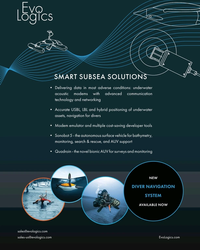 )
March 2024 - Marine Technology Reporter page: 2nd Cover
)
March 2024 - Marine Technology Reporter page: 2nd CoverSMART SUBSEA SOLUTIONS • Delivering data in most adverse conditions: underwater acoustic modems with advanced communication technology and networking • Accurate USBL, LBL and hybrid positioning of underwater assets, navigation for divers • Modem emulator and multiple cost-saving developer tools • Sonobot
-
 )
April 2024 - Maritime Reporter and Engineering News page: 42
)
April 2024 - Maritime Reporter and Engineering News page: 42all proprietary technologies. Two systems op- ingly reliant on digital technology, the of them are crucial,” said Lehtovaara. erating in storm conditions can base their progressive response from shipping is “Shipping is the most ef? cient way of analyses on different ef? ciency param- to engage
-
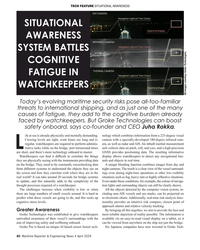 )
April 2024 - Maritime Reporter and Engineering News page: 40
)
April 2024 - Maritime Reporter and Engineering News page: 40situations such as fog, heavy rain or highly re? ective situations. to update, and this naturally adds to the complexity of the Even under these conditions, for example, the colour of naviga- thought processes required of a watchkeeper. tion lights and surrounding objects can still be clearly shown.
-
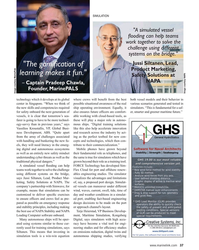 )
April 2024 - Maritime Reporter and Engineering News page: 37
)
April 2024 - Maritime Reporter and Engineering News page: 37different example, means that simulations can be wind, waves, current, swell, tide, time of customized to deliver speci? c exercises day and weather conditions in a simulat- to ensure of? cers and crews feel as pre- ed port, enabling fact-based engineering pared as possible on emergency response design
-
 )
April 2024 - Maritime Reporter and Engineering News page: 35
)
April 2024 - Maritime Reporter and Engineering News page: 35says that a vessel pushing against an offshore wind turbine in severe people are used to accessing information in a variety of short weather and sea conditions, aiming to improve the advanced and entertaining ways. MarinePALS is therefore embracing a navigational safety skills required for CTV ship handling
-
 )
April 2024 - Maritime Reporter and Engineering News page: 21
)
April 2024 - Maritime Reporter and Engineering News page: 21Langford. “We continue to hire key in- oil and gas platforms, the holy grail of rigorous dividuals and partner to provide best-in-class solutions.” R conditions in offshore energy production. From Also – like most companies in the maritime and offshore that start he – like most other burgeoning leaders
-
 )
April 2024 - Maritime Reporter and Engineering News page: 10
)
April 2024 - Maritime Reporter and Engineering News page: 10Maritime Safety © Roman/AdobeStock SIRE 2.0: Navigating the New Horizon of Maritime Safety By Captain Aaron Cooper, Programs Director, OCIMF he maritime industry is on the cusp of a signi? cant preparing vessel operators and vessel assurance teams for the transformation with the launch of the Ship
-
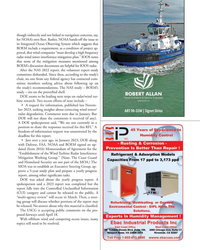 )
April 2024 - Marine News page: 25
)
April 2024 - Marine News page: 25though indirectly and not linked to navigation concerns, say, for NOAA’s own ? eet. Rather, NOAA hands-off the issue to its Integrated Ocean Observing System which suggests that BOEM include a requirement, as a condition of project ap- proval, that wind companies “must develop a high frequency radar
-
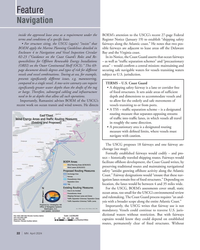 )
April 2024 - Marine News page: 22
)
April 2024 - Marine News page: 22Feature Navigation inside the approved lease area as a requirement under the BOEM’s attention to the USCG’s recent 27-page Federal terms and conditions of a speci? c lease. Register Notice (January 19) to establish “shipping safety • For structure siting, the USCG (again) “insists” that fairways
-
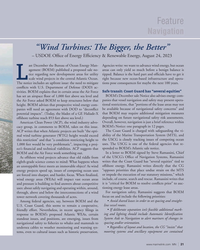 )
April 2024 - Marine News page: 21
)
April 2024 - Marine News page: 21Feature Navigation “Wind Turbines: The Bigger, the Better” – USDOE Of? ce of Energy Ef? ciency & Renewable Energy, August 24, 2023 ast December the Bureau of Ocean Energy Man- Agencies write: we want to advance wind energy, but ocean agement (BOEM) published a proposed sale no- areas can only yield so
-
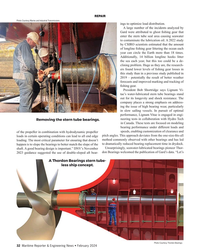 )
February 2024 - Maritime Reporter and Engineering News page: 32
)
February 2024 - Maritime Reporter and Engineering News page: 32loads and speeds, enabling customization of clearance and of the propeller in combination with hydrodynamic propeller loads in certain operating conditions can lead to aft end edge pitch angles. This approach deviates from the one-size-? ts-all loading. The most critical parameter for ensuring that
-
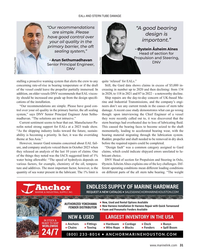 )
February 2024 - Maritime Reporter and Engineering News page: 31
)
February 2024 - Maritime Reporter and Engineering News page: 31, tempera- Øystein Åsheim Alnes explains one of the key challenges. Dif- ture and additives. The most important factor, however, is the ferent operating conditions mean different loading conditions quantity of sea water present in the lubricant. The 1% limit is on different parts of the aft stern tube bearing
-
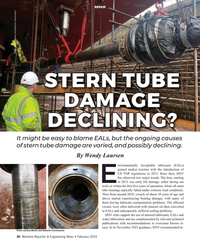 )
February 2024 - Maritime Reporter and Engineering News page: 30
)
February 2024 - Maritime Reporter and Engineering News page: 30life damage, either during sea trials or within the ? rst ? ve years of operation, where aft stern tube bearings typically failed under extreme load conditions. Then from around 2018, vessels of about 10 years of age and above started experiencing bearing damage, with many of them having lubricant contaminatio
-
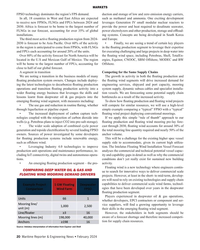 )
February 2024 - Maritime Reporter and Engineering News page: 20
)
February 2024 - Maritime Reporter and Engineering News page: 20vessel capac- cluding IoT connectivity, digital twins and autonomous opera- ity and capability gaps in detail as well as why the commercial tions. conditions don’t yet really exist for sustained new building • An emerging ? oating production segment – the pro- activity. Floating wind is a new technology
